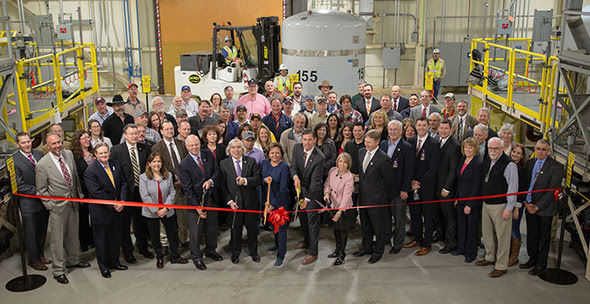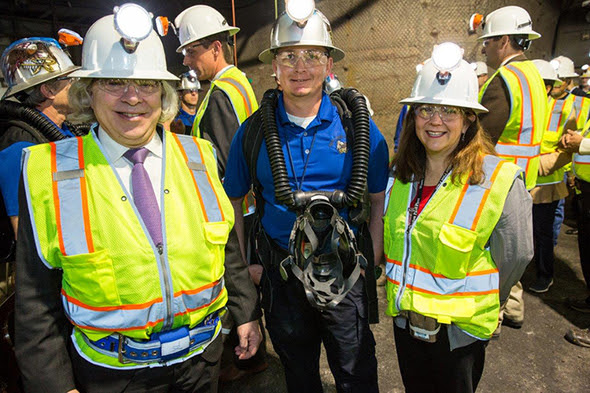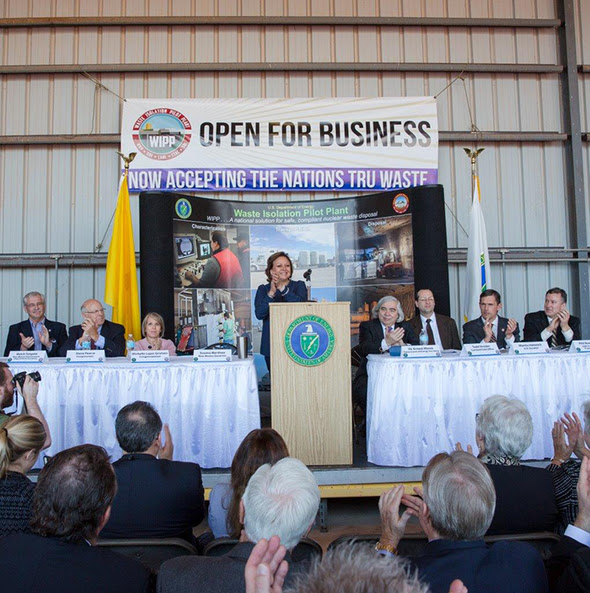Carlsbad Field Office Manager Details WIPP’s Path to Recovery

EM’s
Carlsbad Field Office Manager Todd Shrader, left, and Energy Secretary
Ernest Moniz, following the ribbon-cutting ceremony for the Waste
Isolation Pilot Plant reopening.
CARLSBAD, N.M. – Todd Shrader is the manager of EM’s Carlsbad Field Office (CBFO), which oversees the Waste Isolation Pilot Plant
(WIPP). Shrader is an accomplished leader and engineer with experience
in transuranic (TRU) waste packaging and disposal, engineering for
underground repository environments, project management and safe conduct
of operations. He has more than 26 years of DOE
headquarters and field experience. Below, he discusses the recent
reopening of WIPP. The event marked the end of recovery operations and
resumption of waste emplacement activities, which had been halted in
February 2014 following a waste drum rupture in an underground storage
panel and a separate underground fire.
1. How can you be sure all the requirements to restart WIPP have been adequately addressed, so that WIPP is safe to operate?
In order to ensure WIPP is safe to operate, many improvements at WIPP have been implemented in response to the February 2014 incidents — in the safety management programs such as ground control, work controls, radiological controls, and others. Areas of weakness were identified as Judgments of Need in the DOE Accident Investigation Board Reports. Each Judgment of Need required for resumption of operations has been fully addressed by appropriate corrective actions that were documented in formal, approved Corrective Action Plans. These improvements have been successfully implemented and validated. Additionally, the New Mexico Environment Department (NMED) has provided detailed oversight and, as have the Defense Nuclear Facility Safety Board, DOE Office of Enterprise Assessments, Environmental Protection Agency and the Mine Safety and Health Administration. We have reviewed and overseen WIPP recovery activities to ensure that all findings and recommendations from the reviews have been properly addressed and the corrective actions validated.
Beginning in the fall of 2016, WIPP underwent a series of readiness assessments that included an internal management self-assessment and a contractor operational readiness review (ORR), which was performed by subject-matter experts from across the DOE complex. In late November, DOE conducted the final operational readiness review necessary for restart of operations. Corrective actions were developed for all pre-start findings, and were implemented and validated by CBFO and the DOE ORR team. Corrective action plans were reviewed and approved for all post-start findings and we continue working to close out all actions.
In December, representatives from NMED conducted their annual inspection for compliance with the hazardous waste facility permit and approved WIPP’s return to normal operations.
2. Why did it take so long to resume operations?
We took the time we needed to do things safely and to do them right. It has been roughly 35 months since the fire and radiological release incidents at WIPP in 2014. The recovery process was a first-time experience for everyone involved. The initial reentries into the underground and investigations were done slowly and methodically, to ensure worker safety and to avoid altering the environment that was important to understanding the cause of the incidents.
Recovery activities were complex and required detailed planning and training: cleaning and restoring electrical services impacted by the fire, improvement to safety basis and safety management programs, upgrades to equipment, infrastructure and facilities, ground control (rock bolting, mine stability), characterization and decontamination, etc…The safety of the workers, members of the public, and the environment has always been our priority. I’m very proud of the progress we’ve made to get where we are today.
3. Looking back over the 35 months it took, what was the most challenging part of resuming operations?
Each aspect of recovery presented its own set of challenges and it would be difficult to identify one specific area as most challenging. Moving from working in a clean (uncontaminated) environment, to an environment with potential airborne radioactive contamination was a significant departure from what the workforce had previously experienced. Another challenge was catching up and maintaining ground control after the nine-month hiatus following the events. Ground control, including roof bolting, side bolting and floor leveling, is paramount to worker safety and was necessary to ensure the future stability of the WIPP underground. Catch-up bolting was particularly challenging in the contaminated areas where ground-control teams had to operate bolters in personal protective clothing and respirators. What I’m most proud of is that, at every step of the way, safety has driven our decisions and our workforce has risen to the challenges.
4. How long will WIPP have to operate in a contaminated environment?
With the decision to withdraw from the far south end of the mine, the area of the WIPP underground still considered contaminated was reduced by approximately 60 percent. In addition, due to the hygroscopic (recrystallization of salt brine) nature of the salt, surface contamination levels continue to decrease over time as the radioactive particles are absorbed into the surface of the salt. Therefore, the overall footprint of the contaminated area will continue to decrease, creating an opportunity for some areas to be available for down posting, but in all likelihood some portion of the underground will remain designated as a contaminated area until Panel 7 has been filled and associated closure bulkheads have been installed.
5. When will “normal” operations resume?
We have a new “normal” at WIPP now, based on the program changes and safety enhancements, as well as the reality of operating in a contaminated underground area. When we begin receiving shipments, we will start slowly and ramp up to about five shipments per week. This rate may be slightly increased as we identify efficiencies. These rates are based on the 110,000-cubic-feet-per-minute (cfm) level of underground ventilation that is currently available. We cannot return to higher shipping rates until the new exhaust shaft and filter building projects are completed sometime after 2021, which will provide underground ventilation rates at about 450,000 cfm.
6.
When will transuranic waste shipments from off-site resume? How will
DOE determine the order of waste shipments from generator sites?
Shipments are expected to resume sometime in the spring of 2017, at the rate of up to five shipments per week. The shipping schedule and queue is under development. Considerations in determining priorities will include: the WIPP emplacement rate; waste available for shipping; generator site regulatory commitments and agreements; WIPP transportation/waste acceptance capabilities; programmatic, logistical, and TRU waste storage capacity factors at the generator sites; and operational needs at WIPP and TRU waste generator sites.
7. What are you most proud of today?
I’m most proud of our workforce here at WIPP. Much of the work that was a priority for recovery was in underground areas that had surface contamination or the potential for airborne contamination. Many of the workers have been operating in personal protective equipment and respirators, which made work conditions difficult. In fact these conditions can reduce work efficiency by as much as 75 percent. However, our workforce stepped up and continued to work through the adversity to get us where we are today. I’d like to especially mention the ground-control crews who nearly doubled production over the last few months to help ensure we had safe access to Panel 7 for waste emplacement.
DOE, N.M. Delegation Mark WIPP Reopening With Ribbon-Cutting Ceremony

CARLSBAD, N.M.
– Energy Secretary Ernest Moniz and EM Assistant Secretary Monica
Regalbuto joined members of the New Mexico delegation, including Gov.
Susana Martinez, U.S. Sen. Martin Heinrich, U.S. Reps. Steve Pearce and
Michelle Lujan Grisham, and Carlsbad Mayor Dale Janway for a celebration
this month marking the reopening and resumption of waste operations at EM’s Waste Isolation Pilot Plant
(WIPP) near Carlsbad, N.M. Waste emplacement activities were halted in
February 2014 following a waste drum rupture in an underground storage
panel and a separate underground fire. “The tireless efforts by the
workforce, the contractor and federal management and the community to
make WIPP a safer place to fulfill its critical mission is a remarkable
feat,” Moniz said. Here, Moniz, Martinez and members of the N.M.
congressional delegation cut a ceremonial ribbon in WIPP's Waste
Handling Building on Jan. 9.

National
Champion Mine Rescue Team Captain Heath Fowler, center, shared
information about WIPP's mine rescue team members, who secured the 2016
national championship, with Energy Secretary Ernest Moniz and EM
Assistant Secretary Monica Regalbuto during an underground tour Jan. 9.

Nuclear
Waste Partnership Deputy Manager of Underground Operations Mark Pearcy
describes airflow in the WIPP underground to Sen. Martin Heinrich, from
left, Rep. Michelle Lujan Grisham, Energy Secretary Ernest Moniz and EM
Assistant Secretary Monica Regalbuto. The underground tour was part of a
Jan. 9 event for WIPP's reopening.

N.M.
Gov. Susana Martinez leads a round of applause for the resumption of
waste emplacement at WIPP during the reopening ceremony Jan. 9. Energy
Secretary Ernest Moniz, Sen. Martin Heinrich, Reps. Steve Pearce and
Michelle Lujan Grisham, and Carlsbad Mayor Dale Janway also spoke at the
event.

Workers
underground at WIPP celebrate the completion of the first waste
emplacement since 2014. On Jan. 4, 2017, they emplaced waste from the
Savannah River Site that had been recertified and stored in the Waste
Handling Building (WHB). All recertified waste from the WHB will be
emplaced prior to accepting new waste shipments from generator sites to
WIPP. EM expects to resume shipments to WIPP in spring 2017.

Workers move waste for emplacement underground at WIPP on Jan. 4.

No comments:
Post a Comment